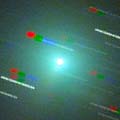
|
It reached to 7.2 mag on July 14 (Maik Meyer). It will be fading gradually after this. Now it is 8.4 mag (Aug. 9, Juan Jose Gonzalez). It kept observable in good condition for a while in the Northern Hemisphere. However, it moves southwards very fast in August. It is only observable until mid August in the Northern Hemisphere. On the other hand, it became observable since mid July in the Southern Hemisphere.
Date(TT) R.A. (2000) Decl. Delta r Elong. m1 Best Time(A, h)
Aug. 11 12 56.97 -2 7.9 1.132 1.015 56 8.4 20:27 ( 77, 13)
Aug. 18 12 49.40 -7 31.5 1.325 1.022 49 8.7 20:17 ( 77, 5)
|

|
It reached to 13.2 mag in last spring (May 12, Carlos Labordena). But now it is not observable. In the Southen Hemisphere, it will be observable again at 15 mag in November. But in the Northern Hemisphere, it will never observable again.
Date(TT) R.A. (2000) Decl. Delta r Elong. m1 Best Time(A, h)
Aug. 11 9 55.45 6 4.8 2.798 1.822 12 13.1 20:27 (111,-18)
Aug. 18 10 11.10 3 18.8 2.818 1.837 11 13.2 20:17 (109,-20)
|

|
Although it had been unobservable for a long time, it appeared in the morning sky finally. Now it is bright as 14.9 mag by CCD (Aug. 2, Vitali Nevski).
Date(TT) R.A. (2000) Decl. Delta r Elong. m1 Best Time(A, h)
Aug. 11 6 0.26 29 57.5 6.565 5.937 48 13.9 3:42 (251, 28)
Aug. 18 6 5.24 29 59.7 6.481 5.939 53 13.9 3:49 (254, 33)
|

|
Now it is bright and visible visually at 13.8 mag (July 21, Bob King). It will be observable in very good condition at 14 mag until autumn.
Date(TT) R.A. (2000) Decl. Delta r Elong. m1 Best Time(A, h)
Aug. 11 0 19.96 -4 53.5 1.450 2.281 134 14.4 3:04 ( 0, 50)
Aug. 18 0 21.26 -5 48.4 1.400 2.281 141 14.3 2:38 ( 0, 49)
|
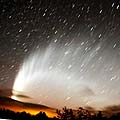
|
Excellent great comet, few times in a lifetime, for southern people. It reached to -5.5 mag on Jan. 14 and 15, brighter than Venus, and visible even in daytime. Then it appeared in the evening sky in the Southern Hemisphere and many people enjoyed a fantastic view of a beautiful great comet, a enormous curving tail with so many striae over 50 degrees. It has already faded down to 12.6 mag (July 6, Walter Ruben Robledo). In the Southern Hemisphere, It keeps observable almost all night until the comet has gone. It will never be observable again in the Northern Hemisphere.
Date(TT) R.A. (2000) Decl. Delta r Elong. m1 Best Time(A, h)
Aug. 11 13 18.03 -64 20.8 3.559 3.726 91 14.3 20:27 ( 25,-22)
Aug. 18 13 30.83 -63 18.3 3.716 3.812 87 14.6 20:17 ( 27,-22)
|
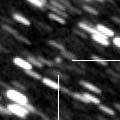
|
Now it is 15.4 mag (June 12, Ken-ichi Kadota). It will reach to 14.5 mag in summer. It moves in the southen sky, and it is observable in good condition in the Southern Hemisphere. However, it will never be observable again in the Northern Hemisphere.
Date(TT) R.A. (2000) Decl. Delta r Elong. m1 Best Time(A, h)
Aug. 11 18 11.85 -56 18.4 2.665 3.359 125 14.4 20:52 ( 0, -1)
Aug. 18 17 52.78 -56 54.3 2.742 3.339 117 14.4 20:17 ( 1, -2)
|

|
It will reach to 11 mag in 2008 spring. It will keep bright for a long time, however, it keeps moving in the southern sky for a while after this. In the Southern Hemisphere, now it is low temporarily. But it will be high after this, then it keeps observable in good condition until 2008 summer. In the Northern Hemisphere, it will appear at 13 mag in November in a short time, but very low and hard to observe. However, it will be visible visually at 11 mag in the evening sky from March to June in 2008. Then it becomes unobservable again. But it will appear in the morning sky again at 13 mag at the end of 2008, then it keeps bright and observable for a while.
Date(TT) R.A. (2000) Decl. Delta r Elong. m1 Best Time(A, h)
Aug. 11 7 28.82 -28 11.2 4.816 4.258 51 14.5 3:42 (290,-22)
Aug. 18 7 38.28 -28 49.8 4.749 4.210 52 14.4 3:49 (294,-17)
|
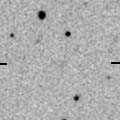
|
It will approach down to 0.4 A.U. to the sun on Oct. 28, and it is expected to reach to 6 mag. However, it was much fainter than expected recently, 17.5 mag on June 17 (Michael Jager) and 18.1 mag on July 25 (Luca Buzzi). The condition in the Northern Hemisphere is very hard. It locates extremely low, slightly over the horizon in the morning sky, from late September to mid October, then it will never be observable again. In the Southern Hemisphere, it will appear in the evening sky in early November, then it keeps observable while fading gradually, although it will not locate very high. It is expected to appear at 7 mag, but it can be much fainter actually.
Date(TT) R.A. (2000) Decl. Delta r Elong. m1 Best Time(A, h)
Aug. 11 10 35.64 28 19.8 2.611 1.708 21 14.9 20:27 (123, 3)
Aug. 18 10 43.28 28 15.6 2.508 1.593 19 14.5 20:17 (124, 2)
|

|
It passed near by the earth in early April, and reached to 8.7 mag (Apr. 10, Werner hasubick). Then it faded down to 11.8 mag on May 26 (Seiichi Yoshida), and became too low to observe in the evening. Now it is not observable. Although it has been unobservable for a long time, now it is appearing in the morning sky finally.
Date(TT) R.A. (2000) Decl. Delta r Elong. m1 Best Time(A, h)
Aug. 11 7 5.09 26 14.5 2.480 1.728 33 14.6 3:42 (247, 13)
Aug. 18 7 2.05 26 37.1 2.432 1.794 40 14.9 3:49 (251, 21)
|
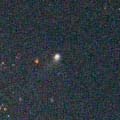
|
Now it is bright and visible visually at 13.2 mag (July 14, Juan Jose Gonzalez). It will be observable at 14 mag at high location from spring to summer both in 2007 and 2008.
Date(TT) R.A. (2000) Decl. Delta r Elong. m1 Best Time(A, h)
Aug. 11 17 3.54 -1 22.5 5.207 5.710 114 14.7 20:27 ( 17, 52)
Aug. 18 16 58.97 -1 16.1 5.311 5.700 107 14.8 20:17 ( 26, 51)
|
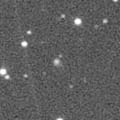
|
It is already bright and visible visually at 14.0 mag (Aug. 8, Alan Hale). It will reach to 10.5 mag and will be observable in good condition in 2008 autumn. It keeps observable in good condition for a long time while the comet is getting brighter slowly.
Date(TT) R.A. (2000) Decl. Delta r Elong. m1 Best Time(A, h)
Aug. 11 21 48.10 -8 36.5 3.752 4.755 170 14.9 0:33 ( 0, 46)
Aug. 18 21 43.44 -8 31.9 3.691 4.700 175 14.9 0:01 ( 0, 47)
|
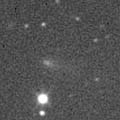
|
Now it is bright as 14.5 mag (July 16, Michael Jager). It will keep bright as 14-15 mag and observable in good condition for a long time until autumn.
Date(TT) R.A. (2000) Decl. Delta r Elong. m1 Best Time(A, h)
Aug. 11 3 14.75 36 23.4 2.086 2.192 82 15.0 3:42 (257, 62)
Aug. 18 3 24.92 38 2.7 2.034 2.211 86 15.1 3:49 (254, 67)
|

|
Appearing in the morning sky after long time blank since last winter. No observations have been reported recently, but it must be already bright as 16 mag. It will reach to 14 mag in next winter, and will be observable in good condition. It is expected to be visible visually. It keeps observable in good condition for a long time until 2008 spring.
Date(TT) R.A. (2000) Decl. Delta r Elong. m1 Best Time(A, h)
Aug. 11 5 32.63 28 12.0 3.389 2.913 54 15.8 3:42 (256, 32)
Aug. 18 5 45.38 28 9.5 3.289 2.883 57 15.7 3:49 (259, 37)
|
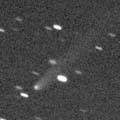
|
It has been visible at 13.5 mag for a long time since 2005 autumn until 2006 spring. However, it has already faded down to 16.7 mag (June 23, Ken-ichi Kadota). Fine tail is visible on CCD images. It is getting lower gradually, and will be too low to observe in September.
Date(TT) R.A. (2000) Decl. Delta r Elong. m1 Best Time(A, h)
Aug. 11 12 55.82 12 23.2 6.898 6.325 52 15.9 20:27 ( 90, 21)
Aug. 18 12 59.50 11 33.2 7.004 6.354 46 16.0 20:17 ( 91, 18)
|

|
Appearing in the moring sky. No observations have been reported since January. But it must have already brightened up to 16.5 mag. It will reach to 13.5 mag in the southern sky in 2008 spring and summer. In the Southern Hemisphere, it keeps observable for a long time after this. However, it is only observable until autumn in the Northern Hemisphere, when the comet brightens up to 15 mag. Then it will be observable again at the end of 2008, when the comet will already fade down to 15 mag.
Date(TT) R.A. (2000) Decl. Delta r Elong. m1 Best Time(A, h)
Aug. 11 1 36.93 -17 9.1 3.388 3.978 118 16.1 3:42 (348, 37)
Aug. 18 1 37.01 -19 15.5 3.259 3.926 124 16.0 3:49 (359, 36)
|

|
First return of a new periodic comet discovered in 1998 at 14 mag. It was recovered at 18 mag in May and June. It is a bit fainter than this ephemeris, but almost as bright as predicted. It will reach to 16 mag until autumn.
Date(TT) R.A. (2000) Decl. Delta r Elong. m1 Best Time(A, h)
Aug. 11 0 29.35 0 43.3 1.923 2.697 130 16.1 3:14 ( 0, 56)
Aug. 18 0 28.81 1 5.8 1.847 2.682 137 16.0 2:46 ( 0, 56)
|
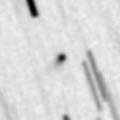
|
It passed very close to the earth in July and reach to 15.5 mag (July 16, Michael Jager). But it will fade out rapidly after August, and will be fainter than 18 mag in September.
Date(TT) R.A. (2000) Decl. Delta r Elong. m1 Best Time(A, h)
Aug. 11 18 20.44 23 42.7 0.291 1.190 120 16.1 21:03 ( 0, 79)
Aug. 18 18 39.24 27 38.5 0.331 1.207 118 16.4 20:54 ( 0, 83)
|

|
Now it is 16.5 mag (Apr. 9, Ken-ichi Kadota). No observations have been reported since June. However, the fading is slow. The comet will be fainter than 18 mag in 2008. In the Northern Hemisphere, it keeps observable until that time.
Date(TT) R.A. (2000) Decl. Delta r Elong. m1 Best Time(A, h)
Aug. 11 5 54.96 64 37.0 3.999 3.603 60 16.1 3:42 (211, 38)
Aug. 18 5 58.65 64 46.6 3.986 3.664 64 16.1 3:49 (211, 41)
|
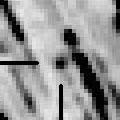
|
It was observed at 16 mag in July. It will be fading gradually after this, and will be fainter than 18 mag in October.
Date(TT) R.A. (2000) Decl. Delta r Elong. m1 Best Time(A, h)
Aug. 11 19 0.62 -21 55.3 2.064 2.960 146 16.1 21:42 ( 0, 33)
Aug. 18 19 0.72 -23 1.7 2.135 2.977 139 16.2 21:15 ( 0, 32)
|

|
Now it is 16.6 mag (July 24, Ken-ichi Kadota). It will reach to 12 mag in 2008 summer. In the Northern Hemisphere, it keeps observable almost all time until that while the comet is brightening gradually. However, it goes to the southern sky and will never be observable again in the Northern Hemisphere after that.
Date(TT) R.A. (2000) Decl. Delta r Elong. m1 Best Time(A, h)
Aug. 11 16 37.66 26 54.5 4.973 5.232 99 16.2 20:27 ( 65, 73)
Aug. 18 16 35.28 25 24.9 4.997 5.180 94 16.1 20:17 ( 69, 69)
|
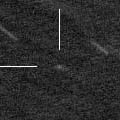
|
Now it is 17.2 mag (June 18, Tony Farkas). It will reach to 15 mag and will be observable in good condition in autumn. Then it keeps observable until it becomes fainter than 18 mag in 2008 spring. However, it was reported as 18 mag or fainter in July, much fainter than this ephemeris.
Date(TT) R.A. (2000) Decl. Delta r Elong. m1 Best Time(A, h)
Aug. 11 2 10.26 18 58.6 1.609 2.059 101 16.4 3:42 (310, 67)
Aug. 18 2 17.99 21 10.0 1.523 2.038 105 16.3 3:49 (321, 73)
|

|
Appearing in the moring sky. No observations have been reported since January. But it must have already brightened up to 16.5 mag. It tends to be brightest after the perihelion passage. It will be observable in good condition at 16 mag until winter.
Date(TT) R.A. (2000) Decl. Delta r Elong. m1 Best Time(A, h)
Aug. 11 6 3.98 20 58.0 3.687 3.086 46 16.4 3:42 (259, 23)
Aug. 18 6 14.16 20 48.6 3.620 3.090 51 16.4 3:49 (263, 27)
|

|
Now it is 16.8 mag (June 18, E. Guido, G. Sostero). It will be observable at 16.5 mag in summer and autumn in 2007, and observable at 17 mag in summer and autumn in 2008.
Date(TT) R.A. (2000) Decl. Delta r Elong. m1 Best Time(A, h)
Aug. 11 17 18.39 -24 1.0 1.847 2.541 122 16.4 20:27 ( 7, 31)
Aug. 18 17 19.88 -23 45.1 1.897 2.514 116 16.4 20:17 ( 11, 30)
|

|
Now it is 16.5 mag (July 25, Katsumi Yoshimoto). Before the perihelion passage, it kept 16.5-17 mag and hardly brightened. After the perihelion passage, it seems hardly to be fading.
Date(TT) R.A. (2000) Decl. Delta r Elong. m1 Best Time(A, h)
Aug. 11 4 13.96 35 41.3 3.157 2.976 70 16.5 3:42 (254, 50)
Aug. 18 4 14.17 37 57.4 3.084 3.016 76 16.5 3:49 (253, 58)
|

|
Now it is 16.4 mag (July 24, Ken-ichi Kadota). It is observable at 16-17 mag in 2007 summer. It will be observable brighter than 18 mag also in 2008, from spring to summer.
Date(TT) R.A. (2000) Decl. Delta r Elong. m1 Best Time(A, h)
Aug. 11 17 45.26 -3 43.3 2.786 3.476 125 16.6 20:27 ( 0, 51)
Aug. 18 17 32.92 -4 43.0 2.897 3.472 116 16.7 20:17 ( 12, 50)
|

|
Now it is 17.1 mag (June 12, Ken-ichi Kadota). It will be observable at 16.5-17 mag in good condition in summer.
Date(TT) R.A. (2000) Decl. Delta r Elong. m1 Best Time(A, h)
Aug. 11 19 49.76 17 35.1 5.040 5.852 139 16.7 22:30 ( 0, 73)
Aug. 18 19 42.84 17 40.1 5.080 5.854 136 16.7 21:56 ( 0, 73)
|

|
Now it is 16.6 mag (July 16, Vitali Nevski). It will brighten rapidly after this. It is observable at 13.5 mag in good condition from autumn to winter.
Date(TT) R.A. (2000) Decl. Delta r Elong. m1 Best Time(A, h)
Aug. 11 0 55.09 10 19.3 1.421 2.130 121 17.1 3:39 ( 0, 65)
Aug. 18 0 58.67 11 49.7 1.325 2.091 126 16.7 3:15 ( 0, 67)
|

|
It reached up to 4 mag in 2006 autumn. But it had faded down to 10.5 mag on Jan. 11 (Carlos Labordena). It had been unobservable for a long time since that, but now it is appearing at dawn again. Now it is 16.8 mag (May 27, Ken-ichi Kadota), fading rather rapidly. After this, it keeps observable until it becomes fainter than 18 mag in autumn.
Date(TT) R.A. (2000) Decl. Delta r Elong. m1 Best Time(A, h)
Aug. 11 22 14.85 -27 32.1 3.478 4.456 162 16.8 1:00 ( 0, 28)
Aug. 18 22 6.51 -28 45.2 3.548 4.529 163 16.9 0:24 ( 0, 26)
|

|
It is expected to reach to 11 mag in 2009 summer. Because it moves in the northern sky, it keeps observable until it becomes brightest in the Northern Hemipshere.
Date(TT) R.A. (2000) Decl. Delta r Elong. m1 Best Time(A, h)
Aug. 11 6 26.48 50 21.2 7.484 6.869 49 16.9 3:42 (227, 31)
Aug. 18 6 29.49 50 52.5 7.355 6.821 54 16.9 3:49 (229, 36)
|

|
Appearing in the morning sky, and observed at 16.7 mag as bright as expected (July 24, E. Guido, G. Sostero). It will be getting higher after this. But it will be fading gradually and becomes fainter than 18 mag in October.
Date(TT) R.A. (2000) Decl. Delta r Elong. m1 Best Time(A, h)
Aug. 11 6 0.21 25 20.1 2.243 1.735 47 16.9 3:42 (256, 25)
Aug. 18 6 19.88 25 56.6 2.210 1.745 50 17.0 3:49 (257, 29)
|
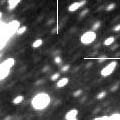
|
Now it is 17.5 mag (July 16, Michael Jager). It is outside of Jupiter's orbit. So it keeps 17 mag for a long time until 2007 summer. It keeps locating high and observable in good condition for a long time after this because it moves in the northern sky.
Date(TT) R.A. (2000) Decl. Delta r Elong. m1 Best Time(A, h)
Aug. 11 3 4.22 36 31.1 3.866 3.896 84 17.1 3:42 (257, 64)
Aug. 18 3 7.80 36 14.2 3.790 3.922 89 17.1 3:49 (259, 71)
|

|
It will reach to 16 mag in autumn, and will be observable in good condition.
Date(TT) R.A. (2000) Decl. Delta r Elong. m1 Best Time(A, h)
Aug. 11 2 31.38 3 11.9 1.611 2.063 101 17.2 3:42 (320, 52)
Aug. 18 2 40.54 3 22.1 1.540 2.056 105 17.1 3:49 (330, 55)
|
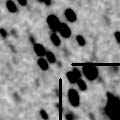
|
It will reach to 6 mag in January, and will be observable in good condition. Now it is 18.3 mag (Aug. 2, Vitali Nevski). In the Northern Hemipshere, it keeps observable until early February, when it fades down to 7.5 mag. In the Southern Hemipshere, it is not observable until late December. But after that, it keeps observable until it fades out.
Date(TT) R.A. (2000) Decl. Delta r Elong. m1 Best Time(A, h)
Aug. 11 1 28.04 73 15.8 2.369 2.458 82 17.7 3:42 (184, 52)
Aug. 18 1 42.20 75 28.7 2.263 2.389 84 17.3 3:49 (181, 50)
|

|
Now it is 18.1 mag (Apr. 14, Maciej Reszelski). It is observable at 17.5-18 mag until autumn. It was discovered at 18 mag in 2006. It is a distant periodic comet, and it keeps observable at 18 mag for 4 years until 2009.
Date(TT) R.A. (2000) Decl. Delta r Elong. m1 Best Time(A, h)
Aug. 11 18 41.87 -15 24.2 3.315 4.158 141 17.4 21:23 ( 0, 40)
Aug. 18 18 39.83 -15 57.9 3.381 4.155 134 17.4 20:54 ( 0, 39)
|
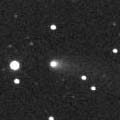
|
It reached to 13.5 mag and became visible visually in 2005 and 2006. Now it has gone far away. But it is observable at 17.5 mag until November.
Date(TT) R.A. (2000) Decl. Delta r Elong. m1 Best Time(A, h)
Aug. 11 2 28.10 8 46.7 3.705 4.012 100 17.6 3:42 (316, 57)
Aug. 18 2 29.56 8 51.5 3.620 4.027 106 17.6 3:49 (330, 61)
|

|
Now it is 18.8 mag (July 26, Filip Fratev). It will reach to 17.5 mag until autumn.
Date(TT) R.A. (2000) Decl. Delta r Elong. m1 Best Time(A, h)
Aug. 11 0 7.63 -6 4.8 2.153 2.986 138 17.8 2:52 ( 0, 49)
Aug. 18 0 6.71 -6 42.1 2.094 2.982 145 17.7 2:24 ( 0, 48)
|
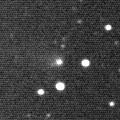
|
It was observed bright as 14-15 mag in 2004 and 2005. Now it is close to the aphelion, but it will be observable at 17.5 mag in good condition in 2007 autumn.
Date(TT) R.A. (2000) Decl. Delta r Elong. m1 Best Time(A, h)
Aug. 11 3 20.37 7 0.4 4.660 4.740 88 17.9 3:42 (302, 47)
Aug. 18 3 22.42 7 0.3 4.564 4.751 94 17.9 3:49 (312, 52)
|
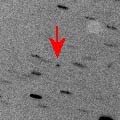
|
Although it is so faint as 18 mag still in August, it will brighten very rapidly in a short time and reach to 15 mag in October. It will be observable at 14.5-15 mag in an excellent condition from October to February.
Date(TT) R.A. (2000) Decl. Delta r Elong. m1 Best Time(A, h)
Aug. 11 4 22.04 31 7.1 2.888 2.701 69 18.3 3:42 (260, 47)
Aug. 18 4 32.89 31 35.7 2.791 2.686 73 17.9 3:49 (262, 53)
|
|
![]()
 C/2007 F1 ( LONEOS )
C/2007 F1 ( LONEOS ) C/2007 E1 ( Garradd )
C/2007 E1 ( Garradd ) C/2005 L3 ( McNaught )
C/2005 L3 ( McNaught ) C/2006 OF2 ( Broughton )
C/2006 OF2 ( Broughton ) 17P/Holmes
17P/Holmes C/2006 S5 ( Hill )
C/2006 S5 ( Hill ) C/2003 WT42 ( LINEAR )
C/2003 WT42 ( LINEAR ) C/2006 U6 ( Spacewatch )
C/2006 U6 ( Spacewatch ) 188P/2007 J7 ( LINEAR-Mueller )
188P/2007 J7 ( LINEAR-Mueller ) 189P/2007 N2 ( NEAT )
189P/2007 N2 ( NEAT ) C/2006 L2 ( McNaught )
C/2006 L2 ( McNaught ) C/2007 O1 ( LINEAR )
C/2007 O1 ( LINEAR ) C/2007 G1 ( LINEAR )
C/2007 G1 ( LINEAR ) 50P/Arend
50P/Arend 128P/Shoemaker-Holt 1
128P/Shoemaker-Holt 1 44P/Reinmuth 2
44P/Reinmuth 2 C/2006 K3 ( McNaught )
C/2006 K3 ( McNaught ) C/2007 M3 ( LINEAR )
C/2007 M3 ( LINEAR ) C/2005 S4 ( McNaught )
C/2005 S4 ( McNaught ) 93P/Lovas 1
93P/Lovas 1 C/2006 M4 ( SWAN )
C/2006 M4 ( SWAN ) C/2006 W3 ( Christensen )
C/2006 W3 ( Christensen ) 108P/Ciffreo
108P/Ciffreo C/2006 M1 ( LINEAR )
C/2006 M1 ( LINEAR ) P/2007 N1 ( McNaught )
P/2007 N1 ( McNaught ) 8P/Tuttle
8P/Tuttle P/2006 F1 ( Kowalski )
P/2006 F1 ( Kowalski ) 117P/Helin-Roman-Alu 1
117P/Helin-Roman-Alu 1 136P/Mueller 3
136P/Mueller 3 P/2004 F3 ( NEAT )
P/2004 F3 ( NEAT ) 110P/Hartley 3
110P/Hartley 3![]()



























